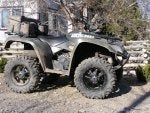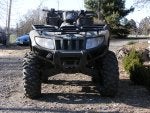Yesterday I put in the 10psi, today they still have 10psi. I am thinking that they seated finally during my 20 minute test ride.
<div class='quotetop'>QUOTE </div>
The tires should say what the max pressure is to seat them. It'll probably be around 30 psi. It may not take that much. You should hear a loud pop when they get seated.[/b]
That's what I did. The ITP rims were very nice, even though made in china. I may have scratched the bead area or gotten some junk in the bead from my shop floor. I mounted them on an old carpet to keep from scratching them up -- who knows what crud was in it. Anyway, my guess is they are fine now.
<div class='quotetop'>QUOTE </div>
For trails I'm going back down to 9-10 psi. I found recommended pressures around 5-6 to be waaaay too low for the type of riding I do on the type of terrain surface conditions we have.[/b]
Good point. I'm going to leave mine at 10 all around for now. I've always felt that tires are for traction and suspension is for bumps. Wallowing bouncy tires complicates the issue. Of course situations can call for low psi -- rock crawling, and sand come to mind.
Here are some of my observations and impressions.
I did some weighing with the bathroom scale; while not super accurate, it should be within a pound -- I weighed everything three times with a zero in between.
Stock carlisle badlands front combo: 24#, rim probably 10#, tire 14#
stock rear badlands: 33#
ITP SS108 14x6: 11#
Maxxis Bighorn 26x9R14: 24#
Of interest to me -- tire weight agrees with the published weight on the website. Back weights are within a couple of pounds. Front weights for this setup are around 10# per tire heavier than stock. Wow. This is my biggest concern. So far though, I don't think I can tell the difference.
frame height static -- 1/2 to 3/4s of an inch higher than stock.
stance -- tires stick out maybe 1 inch wider than stock.
I cannot tell at all that there is increased ride height. That little extra stance probably leverages back the tiny height increase with my weight on it.
I didn't measure diameter changes, but my ride height observations match Wyo H1 Cat's, and visually looked to be about 1.5 inches difference, which is what I think he measured.
My riding impressions on my one short ride are as follows: Traction is hugely improved. The front end cut and tracked in 2x like it was in 4x. Directional stability in ruts and rough seems better -- it goes where you say. It is hard to compare to stock; although I was riding a stretch I have ridden before, it's hard for me to compare. I just push till I feel limits. I think the limits with these tires are higher. I bottomed the right front on one section; I haven't done that with the stock tires. This tells me I was going faster. I'm not sure if the backs were less bouncy because I was focusing on the front feel. My biggest concern with this setup was the extra unsprung weight, especially in the front. I don't believe I can tell that it has any effect. My perception of the front on this short ride was increased steering effort. I know believe that the extreme low psi in the tires was a large part of it. I had some forearm pump, too, which was partly mental anticipation, and partly hanging on too tight because I was really slamming through some of the sections. That kind of tells a tale; I had the confidence to up my speed because of the feel I was getting.
If I ever see mud, I'm sure these will be head and shoulders above stock. Feel free to send me pictures, so I don't miss it for not remembering what it looks like. My last ride on the stockers involved some warm snowdrifts. It was pathetic. I'm sure I could have gone much further with these.
Has anyone noticed more rear CV boot damage with this setup? They look a little exposed now.
I can't wait for another test.
Mike









